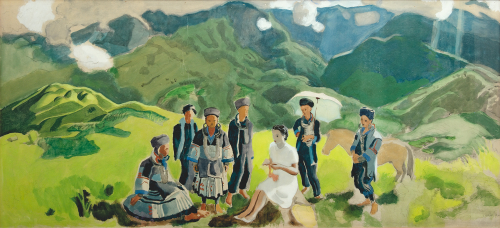
Fiftieth anniversary of the death of the painter Joseph Inguimberty
Joseph Inguimberty in Indochina
Inguimberty disappeared 50 years ago, on October 8th 1971. For several years, the gallery has been committed to defending the work of Joseph Inguimberty, alongside the artist's beneficiaries, and we would like to pay tribute to his memory, the poetry he offered us and to honor his contribution to the extraordinary adventure that was the Hanoi School of Fine Arts, whose sparkles still reach us today.
In the summer of 1924, the young artist from Marseilles had just won the painting prize at the Salon de la Nationale and the proposal he was about to accept would change the rest of his life and career.
The painters Victor Tardieu and Nam Son were in France, in particular to recruit the teaching staff of the Hanoi School of Fine Arts, which they had just founded under the aegis of the colonial administration. Inguimberty was offered the position of professor of decorative arts.
He thus embarked for Indochina without imagining that he would stay there for more than twenty years, living and working close to the first generation of Vietnamese artists. He teaches as much as he learns in these landscapes of the Tonkinese delta that he travels through with his friend, the geographer Pierre Gourou, and which inspire him with a deep, matt palette of subtle greens, ochres and browns.
Today, Joseph Inguimberty is hailed as one of the painters who best captured the soul of his adopted country. He is one of the major actors of this formidable artistic adventure between East and West that was the Hanoi School of Fine Arts, beyond the colonial controversy.
His works, rare on the market, are particularly sought after by art lovers.
Inguimberty à la rencontre des minorités ethniques à Sapa
In this large work on paper currently on display in the gallery, Inguimberty deploys an unusual panoramic setting. He who rather depicts flat rice fields and their workers on the banks of the Red River or corners of ponds under the canopy, shows us here a mountainous setting, on the border of China, where the clouds cling to the peaks.
At the foot of Phan Xi Păng, in this region that the French called "the Tonkinese Alps," a group of Black Hmong surround Jeanne, the painter's wife.
Inguimberty was particularly interested in this ethnic minority, showing in particular, in a series of small works, women sewing, in these traditional dark-colored clothes, which distinguish them from the other Hmong and more broadly from other ethnic groups present in Sapa.
Jeanne, dressed in white, is sitting on a rock in the center of the group. Having flown to Hanoi to accompany her nieces to their parents who were living there (the war had broken out in France and their grandparents could no longer look after them), the young woman, originally from Menton, had met the artist and stayed with him in Indochina. In July 1942, Jeanne and Joseph got married. This work, dated 1942, is an account of their stay in Sapa, probably during the summer, perhaps their honeymoon...
According to his children, if events had not forced him to leave, there is no doubt that Inguimberty, "Mr. I" as his students affectionately called him, would never have left the country he had come to know and love so deeply. He would have continued to build his life there with his wife Jeanne and their children, he would have continued to paint in the rice fields and to teach his students how to build a canvas and how to choose colors, through slow, patient observation of nature, through painstaking learning of the craft.
